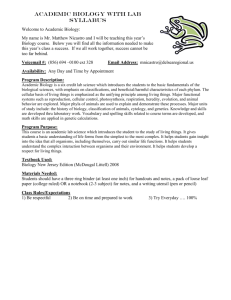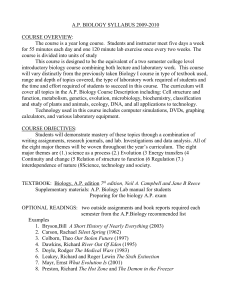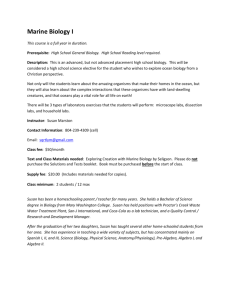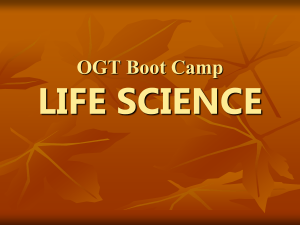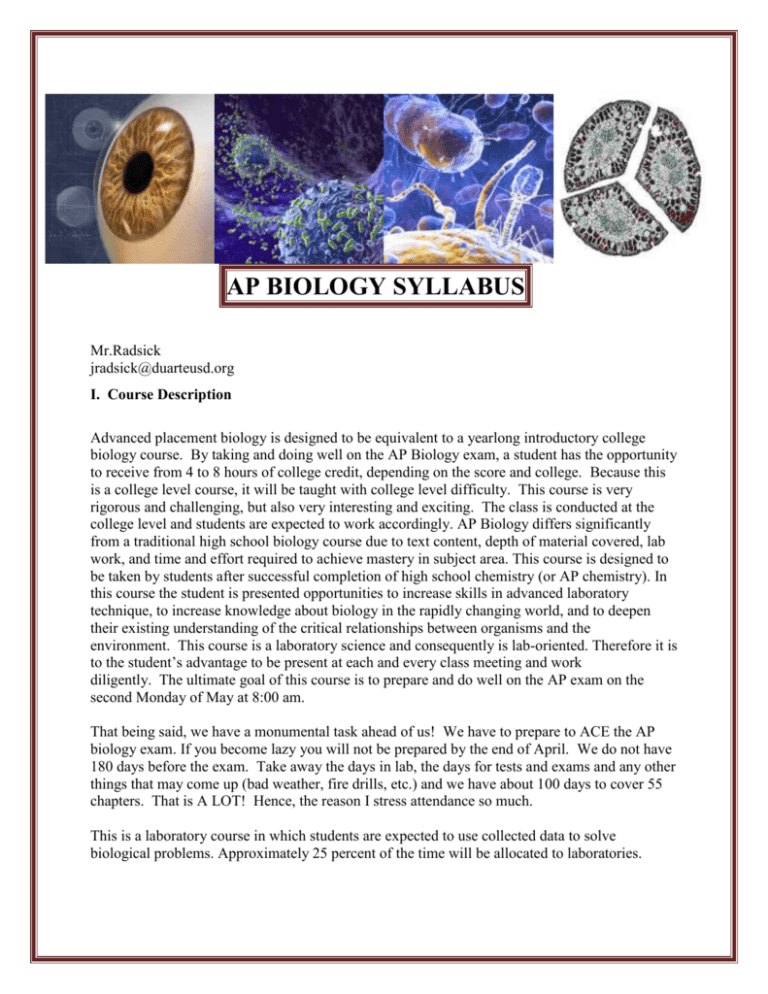
AP BIOLOGY SYLLABUS
Mr.Radsick
jradsick@duarteusd.org
I. Course Description
Advanced placement biology is designed to be equivalent to a yearlong introductory college
biology course. By taking and doing well on the AP Biology exam, a student has the opportunity
to receive from 4 to 8 hours of college credit, depending on the score and college. Because this
is a college level course, it will be taught with college level difficulty. This course is very
rigorous and challenging, but also very interesting and exciting. The class is conducted at the
college level and students are expected to work accordingly. AP Biology differs significantly
from a traditional high school biology course due to text content, depth of material covered, lab
work, and time and effort required to achieve mastery in subject area. This course is designed to
be taken by students after successful completion of high school chemistry (or AP chemistry). In
this course the student is presented opportunities to increase skills in advanced laboratory
technique, to increase knowledge about biology in the rapidly changing world, and to deepen
their existing understanding of the critical relationships between organisms and the
environment. This course is a laboratory science and consequently is lab-oriented. Therefore it is
to the student’s advantage to be present at each and every class meeting and work
diligently. The ultimate goal of this course is to prepare and do well on the AP exam on the
second Monday of May at 8:00 am.
That being said, we have a monumental task ahead of us! We have to prepare to ACE the AP
biology exam. If you become lazy you will not be prepared by the end of April. We do not have
180 days before the exam. Take away the days in lab, the days for tests and exams and any other
things that may come up (bad weather, fire drills, etc.) and we have about 100 days to cover 55
chapters. That is A LOT! Hence, the reason I stress attendance so much.
This is a laboratory course in which students are expected to use collected data to solve
biological problems. Approximately 25 percent of the time will be allocated to laboratories.
II. Course Objectives
Demonstrate skills in using various types of biological instrumentation and scientific
methodologies.
Learn how to read and critique papers written by scientists in the field of biology.
Practice finding and using patterns in collected data to solve scientific problems.
Exhibit mastery of the major principles of biology.
Apply biological knowledge and critical thinking to environmental and social concerns.
III. Goals and Expectations
INSTRUCTIONAL GOALS
Take and PASS the AP Biology Exam on the second Monday of May at 8:00 am.
Students will gain a greater understanding and respect for the complexity of life.
Students will apply their knowledge of the nature of science to problems and activities in
biology.
Students will master fundamental biological concepts in the areas of biochemistry, cell
and molecular biology, genetics, ecology, and evolution.
Students will improve process skills and critical thinking.
STUDENT EXPECTATIONS
Students should make every effort to attend each and every class meeting. If a student is
to be absent, he/she should notify me in advance. The schedule for the year is very tight
and I can make only minor adjustments. If you should miss class, it is YOUR
responsibility to obtain any notes missed. AP labs are difficult to make up. All tests and
projects are made up at lunch.
Students should pay attention in class. Do not do work for other classes in my class. I
expect you to devote yourselves to AP Biology.
You will have homework EVERY night. Most of the homework is reading and
studying. By reading the book, information presented in class will be more easily
understood. Reading a science textbook is not like reading a novel, it requires a slower
pace and attention to detail. Your text is excellent and you have to read it! There are
several good review guides but they are not a substitute for your book.
Students should review each night. Do not wait until the night before a test to try and
learn everything. Cramming for a biology test will not be advantageous and will most
certainly NOT prepare you for your AP exam.
Students are expected to learn the vocabulary. Each unit has numerous vocabulary words
that each student will need to learn in order to understand what the instructor is
discussing and what questions on quizzes and tests are asking.
Students should ask for help when needed. If you do not understand the topic being
discussed, ask questions, ask for help, and ask for clarification. I will be happy to help
you any time I can. I will be available for help every day before school and during lunch.
This course is college level and I run my course as such. Therefore, I run my labs like a
college lab – you do the work – all of it. I do not do things for you except make up
solutions and I only do that to save time. You’ve had chemistry and I expect that you can
make up solutions if you had to. Also, AP labs are very difficult to make up!! Make sure
you come to each class meeting that we have labs!!
The AP exam is on the second Monday of May at 8:00am. We will take a practice
exam sometime at the end of April / first of May.
TEACHER EXPECTATIONS
I will respect all students and their opinions while, at the same time, following and
enforcing school policies and procedures.
I will be available for help by appointment as needed, should it be during or after the
scheduled class meeting time.
I will come to class each day prepared to facilitate learning and provide a positive
environment to encourage success in biology.
I will ensure that each student has every opportunity to succeed and will provide a variety
of instructional strategies to reach various learning styles.
III. Textbooks and Materials
Textbook: Biological Science 2nd Edition , Scott Freeman (2005) Pearson Prentice Hall
AP Biology Cliff notes
Composition book Graph Ruled devoted solely to data recording and laboratory reports
Composition book College Ruled devoted solely to AP for homework assignments
IV. Grading Policy
90-100=A
80-89.9=B
70-79.9=C
60-69.9=D
0-59.9=F
Tests/Quizzes=50%
Laboratories=40%
Homework=10%
ASSESSMENT: A variety of assessments will be used in this course, but the majority of
your grade will be determined by quizzes and tests (to prepare you for the AP
exam.) Periodic quizzes (vocabulary or reading/content-based) will be given to ascertain
student understanding; they may be announced or unannounced. A unit test will be given
upon completion of each unit of study. Unit tests may cover one or several chapters in
the book and will require considerable time. Questions on quizzes and tests will include
material covered during class, in assigned readings and from laboratories. Projects may
also be given for various units of study. You may retake a test; however the highest
grade afforded is 70 percent. Projects will require that students do the bulk of work out of
class. Additionally, since labs are a major part of the AP Biology course, laboratory
reports will be graded.
EVALUATION: Evaluation criteria include participating in and completing classroom
activities, working cooperatively in group assignments, correctly answering questions on
quizzes/tests, completion of assigned projects, communication laboratory data in a correct
and complete manner, and demonstrating proper lab techniques and
safety. Note: Grading rubrics will be provided ahead of time for all major projects,
essays, and lab reports.
GRADING SYSTEM: Grading is based upon a total points system whereby each
assignment is given a number of possible points. Grades are calculated by dividing your
total score by the total points possible, which gives a percentage. Students are expected
to keep track of their own grades on ed-line.
LATE WORK: YOU ARE RESPONSIBLE FOR TURNING IN ALL ASSIGNMENTS
ON TIME AT THE BEGINNING OF CLASS. The highest grade on late work is 70%.
However, all assignments need to be current to receive credit on any work past the last
assignment.
MAKE UP WORK: According to district policy, students must have the ability to make
up any missed work for verified absences. A student is required to bring an excuse to the
Attendance Office and is required to make up work immediately upon arrival. If work is
not made up then the resulting grade will 70% at best. It is your responsibility to make
arrangements to get the work that you miss when you are absent. If you miss a quiz or
test, you will be given a different quiz/test than the class. Labs are particularly difficult
to make up so, make every effort to attend all classes where we will be conducting a lab.
V. Behavior and Personal Performance
In order to maintain a positive and enthusiastic learning environment, rules and daily practices
must be understood and followed. Everyone has the right to learn. No one has the right to
hinder others from learning. Advanced Placement students should be exemplary in their attitudes
and behavior. They are subject to the rules and consequences of Duarte High School on campus
and field trips as outlined in the student handbook. Students are held accountable for their
personal performance. This includes cooperation, participation, and professionalism both in and
out of the classroom.
Big Idea 4: Interactions
Big Idea 3: Information
Big Idea 2: Energy Processes
Big Idea 1: Evolution
§
7. connect & relate knowledge§
5. perform data analysis & evaluation of evidence
§
6. work with scientific explanations/theories
4. plan & implement data collection strategies
3. engage in scientific questioning
2. use mathematics
1. use representations and models
VI. Big Ideas/Science
practices Matrix
Unit 1. Molecules of Life and Nature of Science
Science as a Process:
Measurement Lab
Origin of life Lab
Osmosis and Diffusion Lab
Enzyme Catalysis Lab
Toothpickase and/or Paperase
Activity
§
§
§
§
§
§
§
§
§
§
§
§
§
§
§
§
§
§
§
§
§
§
§
§
§
§
Unit 2. Cell Structure and Function
Cellular Respiration Lab
§
§
§
§
§
§
§
Photosynthesis Lab
§
§
§
§
§
§
§
Cellular Energetics Poster
board Activity
§
§
§
§
§
§
§
§
§
§
§
Unit 3. Cell cycles and Genetics
Classical Genetics of corn
Genetics of Brassica rapa
Mitosis and Meiosis Lab
§
§
§
§
§
§
§
§
§
§
§
§
§
§
§
§
§
§
§
§
§
§
§
§
§
§
§
§
§
§
§
§
§
§
§
§
§
§
§
§
§
§
§
§
§
§
§
§
§
§
§
§
§
§
§
§
§
§
§
§
§
Big Idea 4: Interactions
§
Big Idea 3: Information
6. work with scientific explanations/theories
§
Big Idea 2: Energy Processes
5. perform data analysis & evaluation of evidence
§
Big Idea 1: Evolution
4. plan & implement data collection strategies
§
7. connect & relate knowledge§
3. engage in scientific questioning
§
1. use representations and models
2. use mathematics
Big Ideas/Science practices
Matrix
Unit 4. Molecular Genetics
Microvolumetrics and
pipetting
Restrction Analysis of pARA
and pKAN-R
Producing a Recombinant
Plasmid p-ARA-R
Confirmation of Restriction
and Ligation
Transforming E. coli with a
Recombinant Plasmid
Purification of mFP
Genomic DNA Extraction
from Buccal Epithelial Cells
using PCR
§
§
§
§
§
Unit 5. Evolution
Population Genetics Lab
§
§
§
§
§
§
§
§
Natural Selection Lab
§
§
§
§
§
§
§
§
Artificial Selection Lab
§
§
§
§
§
§
§
§
§
§
§
§
§
§
§
§
§
4. plan & implement data collection strategies
5. perform data analysis & evaluation of evidence
6. work with scientific explanations/theories
7. connect & relate knowledge§
Big Idea 1: Evolution
§
§
§
§
§
§
§
§
§
§
§
§
§
§
§
§
§
§
§
§
§
§
§
§
§
§
§
§
§
§
§
§
§
§
§
§
§
§
§
§
§
§
§
§
§
§
§
§
§
§
§
§
§
§
§
§
§
§
§
§
§
§
§
§
§
§
§
§
§
Big Idea 4: Interactions
3. engage in scientific questioning
§
Big Idea 3: Information
2. use mathematics
§
Bioinfomatics Lab using
BLAST
Big Idea 2: Energy Processes
1. use representations and models
Big Ideas/Science practices
Matrix
§
Unit 6. Plant Form and Function
Transpiration Lab
Electron Microscopy Lab
Leaf Disc Assay Lab
§
§
§
§
§
Unit 7. Animal Form and Function
Circulatory System Lab
Sensory System Lab
Spirometry/VO2max Lab
§
Unit 8. Ecology
Primary Productivity/DO Lab
Animal Behavior Lab
Biome Survey Experience
§
§
§
§
§
§
§
§
§
Unit 1. Molecules of Life and Nature of Science (10-15 days)
Reading: Chapters 1-6
Lecture Topics
Introduction to the four big ideas and enduring understandings.
Essential questions are presented here to demonstrate how the big ideas cross the entire
curriculum.
How have scientists worked together to investigate the science behind the concepts of
biology?
How have scientists built upon the discoveries of other scientists to develop a more
complete picture of the world around us?
How are scientists able to test the validity of their ideas?
What is the significance of structural and chemical adaptations to the resilience of living
organisms?
How do individual species, populations, and biomes impact evolutionary change?
How does energy transfer occur at the molecular level within cells?
What are some examples of the relationship between evolution of organisms and energy
transfer?
How can continuity within a species be controlled while still allowing for gradual change
over time?
How does structure control function at the molecular/cellular level?
How does structure control function at the organism level?
How is the movement of molecules into and out of cells regulated?
How is homeostasis maintained by an organism?
How can interdependence in nature be seen at the molecular level?
How do cells of one organ/tissue rely on the existence of cells in other organs/tissues?
How are all organisms interdependent on each other; how does this relate to evolution?
What advances have been made in laboratory technology to allow scientists to simulate
the natural world?
What is the effect of scientific research and technological innovations on society?
Process of science reviewed:
Scientific method, with emphasis on the fact that there is not ONE way to do science
Explain what is meant by scientific theory
Practice with data collection, analysis, and presentation
Evolution established as foundational theme:
Lamarck vs. Darwin; students will illustrate the difference using several examples
Define mechanism of natural selection and briefly describe what is occurring when a
population is said to evolve
Compare/contrast natural and artificial selection; students will identify what these process
have in common
Chemistry of Life:
Identify basic elements of living organisms
Distinguish between inorganic and organic compounds
List and describe water’s unique properties; relate properties to structure; describe
importance of these properties to living organisms
Contrast condensation reactions (dehydration synthesis) and hydrolysis
Ground Rules for Metabolism:
Apply the first and second laws of thermodynamics to biological systems and how
evolution conforms to, and does not violate, these laws
Explain how the world of life maintains a high degree of organization (continuity and
change)
Investigate enzyme structure and function, and the relationship between enzymes and
energy use, through analysis of data and graphs
Model the role of the participants (substrates, intermediates, enzymes, cofactors, energy
carriers, and products) in a variety of metabolic pathways
Activities:
Measurement lab
Origin of Life lab
Osmosis and Diffusion lab
Enzyme Catalysis
Toothpictase, and paperase enzyme activity
These laboratory experiences encompass nature of science in which students analyze data, create
and revise hypotheses, draw conclusions; understand that conclusions are often tentative and
may be changed with the discovery of new data. Also, students will have the opportunity to
design an experiment, emphasis on development of testable hypothesis, identification of
independent, dependent and controlled variables, procedure development, and data analysis
using mathematics and graphing.
Assessment:
Unit 1. Test on Molecules of Life
Pop quizzes
Free response essays
Lab reports
Unit 2. Cell Structure and Function ( 10-15 days)
Reading Chapters 7-11
Lecture Topics
Demonstrate proper microscope techniques
Cell Structure and Function
Review basic cellular components focusing on structure and function and their evolution
Calculate surface-to-volume ratios in comparing cells of different sizes
Construct models comparing key differences between prokaryotic vs. eukaryotic cell
structure
A Closer Look at Cell Membranes
Create representations of the fluid mosaic model
Explain the concept of selective permeability as it applies to cell membrane function
Distinguish between passive and active transport
Compare cell communication processes in different types of organisms
Plants and Animals—Common Challenges
Define homeostasis in relation to the internal environment of an organism
Compare negative and positive feedback processes in a plant and an animal
Illustrate, with examples, how a cell uses diffusion and active transport to maintain an
internal environment
Evaluate data that are suggested to indicate circadian rhythms in organisms
Explain the process of apoptosis as a normal process
Cell membrane, Organelles and compartmentalization, Nuclear pore regulation
Cell comparisons, Cell signaling, Cell to cell connections
Cell respiration (Glycolysis, Krebs Cycle, Electron Transport Chain, and Fermentation)
Angiosperm/gymnosperm leaf anatomy
Chloroplast structure and function
Light reactions/light-dependent reactions
Light-independent reactions/Calvin cycle
C3 and C4 cycles
The role of photosynthesis and respiration in global warming
Labs/Activities/Projects
Lab 4. Plant Pigments and Photosynthesis
Lab 5. Cell Respiration
Cellular respiration Project
Philosophical Chair (Should Insurance Companies have access to your genome)
Cell microscopy experience
Assessment
Unit 2 Test on Cells, respiration and photosynthesis
Pop quizzes
Free response essays
Lab reports
Unit 3. Cell Cycle and Genetics (15-20 days)
Reading Chapter 11-16
Lecture Topics
How Cells Reproduce
Compare each stage of the cell cycle in normal versus cancerous cells
Explain the difference between mitotic division and cytokinesis; compare differences in
the processes between animal and plant cells
Discuss the process by which cancers form
Review experimental data about cell differentiation
Meiosis and Sexual Reproduction
Distinguish between the processes of mitosis and meiosis; distinguish between somatic
and germ cells
Explain why meiosis is important for survival of a species and relate to evolutionary
processes
Illustrate the cellular events that occur during each phase of meiosis I and meiosis II and
explain the biological implication of each
Communicate to fellow students the importance and mechanism of crossing over and
how one would recognize if crossing over occurred
Reproductive Mechanisms
Discuss mechanisms that increase genetic variation; relationship to evolutionary fitness
Revisit alternation of generations in the context of evolution of organisms; sexual vs.
asexual; viral replication
Describe the double fertilization that occurs uniquely in the flowering plant life cycle
Report on modern biotechnological techniques and parthenogenesis, vegetative
propagation, and tissue culture propagation
Differentiate between growth and development; discuss regulation mechanisms
Observing Patterns in Inherited Traits
Discuss the significance of the work of Mendel
Collect and analyze data related to several different inheritance patterns
Construct and interpret Punnett squares; apply product rule
Construct and interpret pedigrees
Chromosomes and Human Inheritance
List several examples of human inheritance patterns Discussion: What are some benefits
of genetic screening and genetic counseling? Would you want to know if your child had a
genetic disease?
Labs/Activities/Projects
Lab 3. Mitosis and Meiosis
Lab 7. Genetics of Organisms
Genetics Problems, family tree
City of Hope Scientist Principle Investigator Dr. Kane will visit and discuss her labs
research on effects of Herceptin in breast cancer
Assessment
Unit 3. Test on Genetics
Pop quizzes
Free response essays
Lab reports
Unit 4. Molecular Genetics (20-25 days)
Reading Chapters 17-20
Lecture Topics
How do Scientist use micro-pipetting and gel electrophoresis to separate molecules?
How did the Meselson-Stahl experiment help explain how cells reproduce?
How are plasmids used in molecular biology?
What has to be part of a recombinant DNA molecule for selecting purposes?
Use of restriction enzymes, ligase and bacterial transformations.
Purification of mutant fluorescent protein from cell lysate through column
chromatography.
Genomic DNA extraction from buccal epithelial cells (ALU element) using PCR.
Use of Taq polymerase in a thermal cycler.
Central dogma, Genetic code, Chargaff rules
Exons and introns
Transcription and translation
Control of gene expression in bacteria and eukaryotes
Biotechnology
Labs/Activities/Projects
Bruce Wallace AMGEN biotechnology program
Lab 1. An introduction to microvolumetrics and pipetting
Lab 2. Restriction analysis of pARA and pKAN-R
Lab 3. Ligation of pARA/pKAN-R restriction fragments producing a recombinant
plasmid, pARA-R
Lab 4. Confirmation of restriction and ligation using agarose-gel electrophoresis
Lab 5. Transforming Escherichia coli with pARA-R
Lab 6. Preparing an overnight culture of Escherichia coli with pARA-R
Lab 7. Purification of mFP from an overnight Culture
Lab 8. Genomic DNA extraction from buccal epithelial cells
City of Hope PI Dr. Kane Brest cancer research presentation/molecular biology lab
Group project and presentation on methodology and instrumentation of Biotechnology
Assessment
Unit 4. Test on Molecular Genetics
Pop quizzes
Free response essay
Lab reports
Unit 5. Evolution (10-15 days)
Reading Chapters 23-26
Lecture Topics
Evidence of Evolution
Describe and justify the evidence Darwin used to develop the theory of natural selection
Microevolutionary Processes
Distinguish between microevolution and macroevolution
Relate differences that occur in gene pools, alleles, and allele frequency to each other
Calculate allele frequencies in populations in Hardy-Weinberg equilibrium selection
Distinguish the founder effect from a bottleneck
Distinguish between an adaptation and an evolutionary adaptation
Evolutionary Patterns, Rates, and Trends
Discuss the biological species concept; and how pre/post-zygotic mechanisms; allopatric
and sympatric speciation contribute to this concept
Explain the relationship between gene flow and genetic divergence
Evaluate phylogenetic trees to see how taxonomy reflects evolutionary history
Create a model illustrating mass extinctions
Life’s Origin and Early Evolution
Summarize and compare current hypotheses for how and where life began
Explain how we know that DNA is the hereditary material, as opposed to other molecules
Describe how the endosymbiosis theory may help explain the origin of eukaryotic cells;
describe the modern evidence supporting this theory
Understand the basic timeline of the evolution of life and the key events along the
timeline
Discuss and compare the kingdoms in relation to evolution of structures, metabolism, and
cellular organization; classification (systematics, phylogeny, cladograms); role in the
biosphere (niche); life cycles.
Labs/Activities/Projects
Lab 8. Population Genetics and Evolution
Organismal analysis of natural selection
Socratic Seminar (religion and science)
Natural selection lab Brine Shrimp
Artificial selection lab with Brassica rapa
BLAST bioinformatics lab
Assessment
Unit 5. Test on Evolution
Pop quizzes
Free response essays
Lab reports
Unit 6. Plant Form and Function 10-15 days
Reading Chapters 29 and 35-40
Lecture Topics
Plant Homeostasis & Transport
Explain how plant cells regulate the movement of water and organic materials (bulk flow,
translocation, and cohesion-tension theory)
Explain how plants interact with virtually every other terrestrial organism.
How do plants adapt to environments that are dry?
Compare and contrast the form and function of the root and shoot system of plants
Analyze growth of and development of plants and green algae
Investigate plant nutrition through experiment.
Model the experiments leading to the understanding of the role of each class of plant
hormones
Create time-lapse movie of tropisms and explain how each is regulated
Interpret data collected about the activity of organisms with circadian cycles and
biological clocks and compare to organisms without photoperiodic responses
Describe the action of phytochrome and the role it plays in long-day, short- day, and dayneutral plants.
Differentiate between sporophyte and gametophytes pertaining to plant reproduction.
Labs/Activities/Projects
Lab 9. Transpiration
Field trip to City of Hope Hospital/Biomedical Research center Electron Microscopy Lab
Dr. Miller and Dr. Manthey
Leaf disc assay to investigate photosynthesis
Limiting nutrient in plants lab
Botany morphology activity
Conifer reproduction lab
Philosophical chair (Landfill wastes and human population)
Assessment
Unit 6. Test on Plant Form and Function
Pop quizzes
Free response essays
Lab reports
Unit 7. Animal Form and Function (20-25 days)
Reading Chapters 41-49
Lecture Topics
Body size and its influence on diffusion mediated processes, such as gas exchange,
nutrient absorption, and waste exchange.
Homeostasis, regulation and feedback mechanisms
Water and electrolyte balance in aquatic environments, terrestrial insects and terrestrial
vertebrates
Digestive system and nutritional homeostasis for nitrogen balance, calorie balance
mechanisms
Gas exchange and circulation as a mechanism of transportation of wastes, heat, and
nutrition
Explore how electrical signals in animals occur due to resting membrane potential.
Explain the role of the sodium potassium pump, sodium leak channels, and potassium
leak channels.
Describe the events of an action potential by means of ion influx and efflux.
Describe how an electrical signal transfers to a chemical signal through events at the
presynaptic membrane and postsynaptic membrane.
Explain how neuron summation is the result of excitation and inhibition.
Describe the function of the Central Nervous System and how it transmits information to
and from the peripheral nervous system.
Explore how sensory receptors detect environment changes through interaction.
Explain how motor proteins enable movement and how structural systems support
movement and homeostasis.
Differentiate between chemical and electrical signals in animals.
Differentiate between peptide and steroid hormones in their response to environment.
Explain reproductive strategies for animals like external vs internal fertilization,
placental, amniotic eggs, sexual, and asexual.
Discuss developmental processes prezygotic, zygotic, and postzygotic, cleavage,
gastrulation, and organogenesis.
Differentiate between the innate and acquired immune system in its response to a
pathogen or assault.
Compare and contrast cell-mediated immunity with humoral immunity.
Labs/Activities/Projects
Citrus College Field trip (Cat dissection, EKG, and Muscle myogram lab)
Vision lab
Sensory perceptions lab
Action potential activity
Reflex activity
Class debate (designer babies)
Lab 10. Circulatory Physiology
VO2 max activity
The Nephron game
Salivary amylase lab
Mammalian dissection
Assessment
Unit 8. Animal Form and Function
Pop quizzes
Free Response essays
Lab Reports
Unit 10. Ecology (10 to 15 days)
Reading Chapters 50-55
Lecture Topics
Population Ecology
Analyze and interpret logistic and exponential growth curves
Convert data tables into different survivorship curves and age structure diagrams
Community Structure and Biodiversity
Contrast types of symbiosis
Relate community interactions to coevolution
Compare succession within different communities
Ecosystems
Compare biogeochemical cycles in terms of the role of different organisms
Analyze trophic levels and calculate flow of energy through food chain/web/pyramid
Biosphere
Students report on different biomes
Discussion topic: Impact of humans on the biosphere. What can we do?
What should we do? How do our decisions/actions affect other species?
Behavioral Ecology
Compare animal behavior in different environments and to different stimuli
Compare/contrast the role of the environment and genes on behavior with both animal
and plant examples
Explain how adaptive behavior, social behavior, selfish behavior, and altruism can all
promote an individual’s reproductive success (fitness); what are the costs/benefits of each
behavior?
Labs/Activities/Projects
Lab 12. Dissolved Oxygen and Aquatic Primary Productivity from
Biome overview project
Philosophical chair (nuclear waste, and human impact)
Class debate (global warming/alternate fuels)
Assessment
Unit10. Test on Ecology
Pop quizzes
Free response essays
Lab reports
Student Name: ______________________________________________
Student Email: _______________________________________________
Title of Course: ______________________
Class Period:__________
To the Student and Parent(s)/Guardian(s):
STUDENT AGREEMENT
I, ______________________, have read the syllabus for AP Biology and agree to abide by the rules and
consequences set by Mr. Radsick and Duarte High School. I acknowledge my responsibilities in
undertaking such a rigorous and challenging course. I am aware of the AP Biology testing, grading and
make-up / late policies. I agree to ask for help if necessary and attend the required number of afterschool review sessions to prepare myself for the AP Exam.
_______________________________
______________________________
Student signature
Date
STUDENT SAFETY CONTRACT
I, ______________________, a student in science at Duarte High School, do hereby agree to follow all
safety rules and regulations as set forth by the instructor. I realize that compliance with these rules is
necessary to assure the safe operation of the school laboratory and provide safe environment not only
for myself, but also for my fellow students and teachers as well. I will, therefore, cooperate fully with
the teacher and students to assure all of us the safest laboratory possible. I will act responsibly to look
for possible safety hazards and will immediately point out these hazards to the instructor. I understand
that violation of safety rules may result in the loss of laboratory privileges and possible disciplinary
measures.
________________________________
____________________________
Student Signature
Date
STUDENT AND PARENT COURSE CONSENT
We have read and understand the expectations for AP Biology and will support Mr. Radsick in his effort
to provide an effective learning environment. We also understand that this course is a college level
course that will require a significant amount of effort on the part of the student.
____________________________________
Student’s Signature
_________________________________________
Parent’s Signature
Home Phone Number
Parent E-mail Phone Number at which
parent/guardian can be reached during school hours.
Are there any requests that you have of the instructor?

